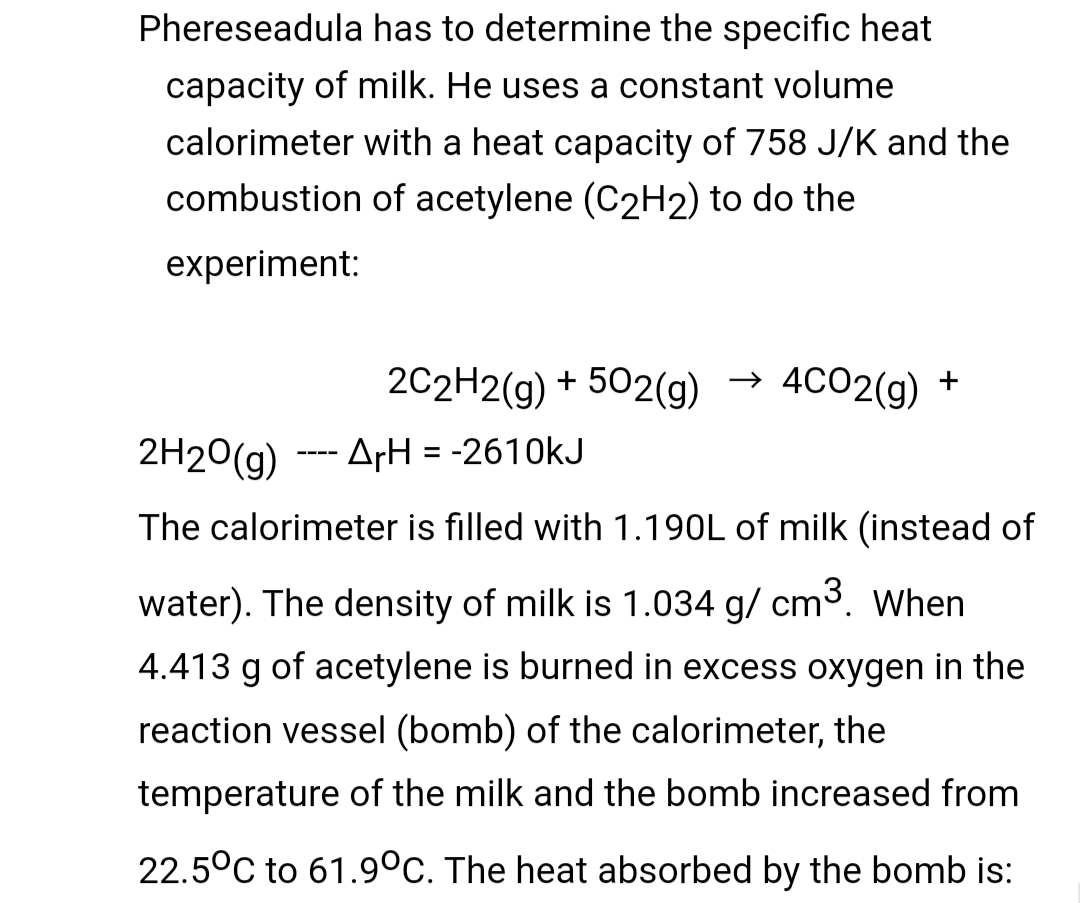Phereseadula has to determine the specific heat capacity of milk. He uses a constant volume calorimeter with a heat capacity of 758 J/K and the combustion of acetylene (C2H2) to do the experiment: 2C2H2(g) + 502(g) 4CO2(g) + 2H20(g) ---- ArH = -2610kJ The calorimeter is filled with 1.190L of milk (instead of water). The density of milk is 1.034 g/ cm3. When 4.413 g of acetylene is burned in excess oxygen in the reaction vessel (bomb) of the calorimeter, the temperature of the milk and the bomb increased from 22.5°C to 61.9°C. The heat absorbed by the bomb is:
Phereseadula has to determine the specific heat capacity of milk. He uses a constant volume calorimeter with a heat capacity of 758 J/K and the combustion of acetylene (C2H2) to do the experiment: 2C2H2(g) + 502(g) 4CO2(g) + 2H20(g) ---- ArH = -2610kJ The calorimeter is filled with 1.190L of milk (instead of water). The density of milk is 1.034 g/ cm3. When 4.413 g of acetylene is burned in excess oxygen in the reaction vessel (bomb) of the calorimeter, the temperature of the milk and the bomb increased from 22.5°C to 61.9°C. The heat absorbed by the bomb is:
Physical Chemistry
2nd Edition
ISBN:9781133958437
Author:Ball, David W. (david Warren), BAER, Tomas
Publisher:Ball, David W. (david Warren), BAER, Tomas
Chapter2: The First Law Of Thermodynamics
Section: Chapter Questions
Problem 2.83E: Benzoic acid, C6H5COOH, is a common standard used in bomb calorimeters, which maintain a constant...
Related questions
Question

Transcribed Image Text:Phereseadula has to determine the specific heat
capacity of milk. He uses a constant volume
calorimeter with a heat capacity of 758 J/K and the
combustion of acetylene (C2H2) to do the
experiment:
2C2H2(g) + 502(g)
4CO2(g) +
2H20(g) --- ArH = -2610kJ
The calorimeter is filled with 1.190L of milk (instead of
water). The density of milk is 1.034 g/ cm3. When
4.413 g of acetylene is burned in excess oxygen in the
reaction vessel (bomb) of the calorimeter, the
temperature of the milk and the bomb increased from
22.5°C to 61.9°C. The heat absorbed by the bomb is:
Expert Solution
This question has been solved!
Explore an expertly crafted, step-by-step solution for a thorough understanding of key concepts.
Step by step
Solved in 6 steps with 5 images

Knowledge Booster
Learn more about
Need a deep-dive on the concept behind this application? Look no further. Learn more about this topic, chemistry and related others by exploring similar questions and additional content below.Recommended textbooks for you

Physical Chemistry
Chemistry
ISBN:
9781133958437
Author:
Ball, David W. (david Warren), BAER, Tomas
Publisher:
Wadsworth Cengage Learning,

Chemistry: The Molecular Science
Chemistry
ISBN:
9781285199047
Author:
John W. Moore, Conrad L. Stanitski
Publisher:
Cengage Learning

Chemistry: Principles and Reactions
Chemistry
ISBN:
9781305079373
Author:
William L. Masterton, Cecile N. Hurley
Publisher:
Cengage Learning

Physical Chemistry
Chemistry
ISBN:
9781133958437
Author:
Ball, David W. (david Warren), BAER, Tomas
Publisher:
Wadsworth Cengage Learning,

Chemistry: The Molecular Science
Chemistry
ISBN:
9781285199047
Author:
John W. Moore, Conrad L. Stanitski
Publisher:
Cengage Learning

Chemistry: Principles and Reactions
Chemistry
ISBN:
9781305079373
Author:
William L. Masterton, Cecile N. Hurley
Publisher:
Cengage Learning

Chemistry for Engineering Students
Chemistry
ISBN:
9781337398909
Author:
Lawrence S. Brown, Tom Holme
Publisher:
Cengage Learning

Chemistry by OpenStax (2015-05-04)
Chemistry
ISBN:
9781938168390
Author:
Klaus Theopold, Richard H Langley, Paul Flowers, William R. Robinson, Mark Blaser
Publisher:
OpenStax

General Chemistry - Standalone book (MindTap Cour…
Chemistry
ISBN:
9781305580343
Author:
Steven D. Gammon, Ebbing, Darrell Ebbing, Steven D., Darrell; Gammon, Darrell Ebbing; Steven D. Gammon, Darrell D.; Gammon, Ebbing; Steven D. Gammon; Darrell
Publisher:
Cengage Learning